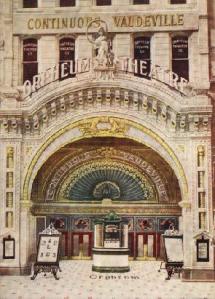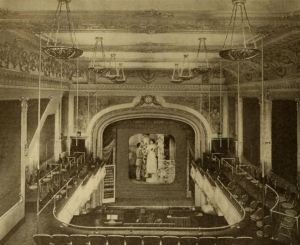112 South State Street
Built 1907
Architects: Holabird & Roche

Orpheum Theater, ca. 1907
When it opened in 1907, the Orpheum Theater was one of the largest and most popular vaudeville theaters in Chicago. Located on State Street near Monroe in the heart of the Loop, the theater was ideally situated to attract large crowds. During its early years, the Orpheum offered “continuous vaudeville.” The first show of the day began at nine in the morning and performances continued until eleven in the evening, pausing only long enough to clear out one audience and usher in the next. At a rate of fifteen fifty-minute shows a day, the seven-hundred-seat theater could accomodate nearly 325,000 patrons a month. Actual monthly attendance typically reached 200,000, or over sixty percent capacity, a remarkable figure given the number of early morning performances. Saturdays were the busiest days at the Orpheum, when attendance often surpassed 10,000.
The Orpheum was part of the booming Jones, Linick, and Schaefer theater circuit, a chain of Chicago vaudeville and movie houses run by impresario Aaron J. Jones. Other Jones, Linick, and Schaefer theaters included the adjoining Bijou Dream Theater at 178 State Street and several showplaces at the city’s two amusement parks, White City and Riverview Park.

Orpheum Theater, interior view, ca. 1911
What distinguished the Orpheum from the city’s other vaudeville houses was not only its highly accessible location, but also its sumptuous appearance and well-disciplined personnel. The theater’s entryway, which consisted of a two-story arch adorned by classical sculptures and bright electric lights, was purposely designed to catch the eye of passersby and quickly became a State Street landmark. The theater itself was housed in the first two floors of the five-story structure. Its double-aisled main floor featured plush, opera-style seats and the brass-railed balcony included several boxes that were comparable in size and comfort to those of any “legitimate” theater in the city. The Orpheum’s six-thousand-dollar ventilation system, which provided a steady flow of fresh, water-cooled air throughout the theater, was state-of-the-art and won the praise of reformers who often cited, justifiably or not, the lack of ventilation in theaters as a serious health threat.
High-quality customer service also attracted Chicagoans to the Orpheum. The thirty-five-person workforce included approximately two dozen ushers who were rigorously trained in how best to treat visitors to the theater. Ushers and other theater service personnel were expected by management to be polite and courteous at all times and to use “please” whenever speaking to a patron. House manager Samuel Levin frequently reminded his employees that any sign of neglect or disrespect toward a customer would not be tolerated. It was in part the high level of customer service that gave the Orpheum a reputation among patrons as the premiere vaudeville house in the city and gave them the willingness to pay ten cents for admission when theaters just down the street charged only five.
In 1909, the owners of the Orpheum dropped the vaudeville program and switched to showing motion pictures interspersed by sing-along slide shows, a popular diversion in its day. The switch to movies increased the theater’s popularity and number of patrons. In 1913, for instance, the theater attracted over 2.64 million customers, more than Chicago’s total population at the time. Such numbers, observed Variety, earned “something in the neighborhood of a hundred thousand dollars profit for the owners.”
Internet Resources
Photograph: Orpheum Theater, exterior view, ca. 1907 [Univ. of Minnesota Library]
Source: Variety, 16 Jan. 1914, 23.
Image sources: “Orpheum Theatre, 174-176 State Street, Chicago,” postcard, The Simplicity Co., n.d.; Motion Picture World, 14 Oct 1911, pg. 116.
